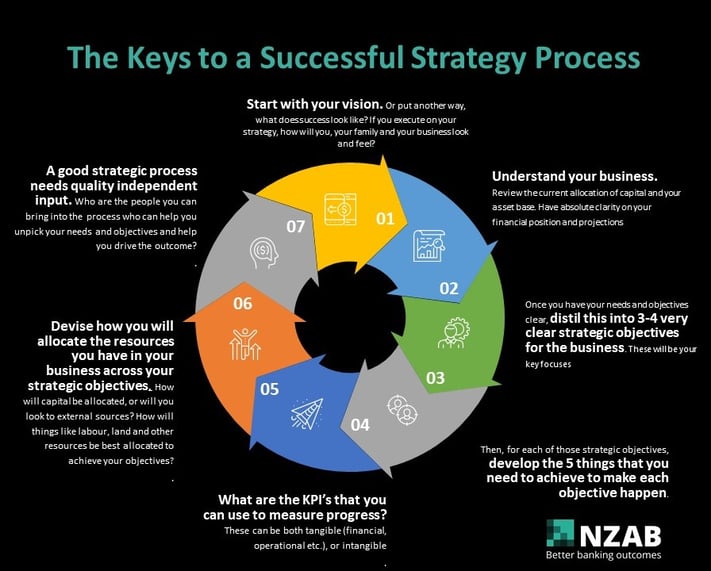 Tom Laming, Client Director, NZAB
Tom Laming, Client Director, NZAB
If you are anything like most businesses – farming or otherwise – you will be hearing the word “strategy” a lot at the moment. Your Bank is probably looking for one, you might need one for your fertiliser company or to meet regulatory requirements, or you might just be wrestling with how to develop a strategy for your own family and business.
Whatever the circumstances, you may well be asking “where do I start?” What exactly is a strategy, what is the process to develop one and what should it look like once I’m done? And most importantly, why will a strategy benefit my business? Why should I get excited about the process?
From the biggest corporate on down, businesses through the generations have attempted to develop strategies that clearly capture the needs and aspirations of all key stakeholders – from the biggest shareholder to the family who own and operate the business.
Some become clearly defined. I have recently finished a book by Bob Iger, the current CEO of Disney. For context, Disney had revenue of nearly USD70 billion in 2019! His strategy for the business however was simple and was captured in only three key focuses – to increase the amount of branded content the company created, embrace and advance technology, and be a truly global player. Under his leadership Disney has doubled it’s revenue, and cemented a dominant position in the media landscape.

On the other hand, strategy can end up being a complex process that leaves the participants lacking clarity, frustrated and without a clear direction in which to head.
Why is a clear strategy the key to achieving your goals and objectives?
Before we get into the theory, why is a clear strategy important? Why is it something to be excited about, rather than seeing it as just another thing to tick the box on?
To me, a good strategy is the framework to many things. It will give you and all the key people in your business clarity and purpose. It should unlock opportunities and growth. It should leave you with a clear sense of control, and the confidence to act. And it should ensure that there is complete alignment with the people who are key to making your business successful, and a framework to hold those people to account.
Where we see strategy being done well we also see things like a higher degree of family harmony, better business performance, smoother and more balanced succession processes, and a shared and committed vision that means businesses can both overcome any challenges thrown at them. Those businesses also have the absolute confidence to take opportunities when they see them - a confidence born out of the knowledge that their strategy has been tested and analysed and that decisions are supported by good information and a robust process.
Don’t let others set your strategy. Even worse, don't let it be the bank.
The other reason to take strategy seriously is about ownership. As we have already touched on, you are likely to be asked to provide a strategy to a range of stakeholders. In the absence of you taking ownership of that process, it’s likely you will have a strategy imposed on you - whether you like it or know it!
That could mean Banking conditions or structure that aren’t fit for purpose, limitations on access to capital, operational restrictions or other constraints imposed on the way you want to operate. That can be hugely detrimental to your business, your confidence, and the ability to make decisions that protect and create value. At its worst, having a strategy imposed on you can undermine or destroy what you have created. You can end up feeling stuck - like you have no control or influence over where you’re business heads.
What are the keys to a successful strategy process?
So lets keep it simple. What should a good strategic process involve?

- Start with your vision. Or put another way, what does success look like? If you execute on your strategy, how will you, your family and your business look and feel?
What success looks like will differ from business to business, as will the timeframes you define. For some, success may be just about survival. For others, success may look like a well-executed succession process and a business that can meet the needs of multiple generations. Whatever it is, clarifying that vision or definition of success will become the central and unifying force that you develop your strategy around.
Its also what you fall back to when times are tough, or when you are trying to make decisions that will shape the future of your business.
- Understand your business. Review the current allocation of capital and your asset base. Have absolute clarity on your financial position and projections, and the key levers in your business that you can control and influence. Good information is critical.
- Once you have your needs and objectives clear, distill this into 3-4 very clear strategic objectives for the business. These will be your key focuses – the elements of your business where you invest time, expertise and capital. They will form the basis of your decision making, how you communicate to those who will be instrumental in supporting the focuses, and feed into the way you run your business
- Then, for each of those strategic objectives, develop the 5 things that you need to achieve to make each objective happen.
As an example, one of your strategic objectives might be to improve profitability to support growth and grow options. In order to achieve that objective, what do you need to do? It could be targeted investment on-farm, developing better systems to monitor performance, enhancing the skill-sets of the people in your business, or bringing outside expertise.
- What are the KPI’s that you can use to measure progress? These can be both tangible (financial, operational etc), or intangible – more balance, a feeling of progress, family harmony etc. They are also the elements that you can hold yourself accountable to, or others can help with. Make sure you pick the right KPI’s – they need to be meaningful, be able to be measured and genuinely support the execution of the strategic objectives you develop.
- Lastly, how do you allocate the resources you have in your business across your strategic objectives? How will capital be allocated, or will you look to external sources? How will things like labour, land and other resources be best allocated to achieve your objectives?
- A good strategic process needs quality independent input. Who are the people you can bring into the process who can help you unpick your needs and objectives? Who can help you understand your business and what makes it tick. And who can support the execution of the plan, and the accountability needed to achieve it.
A good strategy is a powerful enabler to achieving personal and business success and get access to the best banking terms and rates.
It will also help you “look through” the ups and downs between years and business cycles. If you are taking a 10 year view you, don’t over react to every little thing and you keep the focus on the big end prize – your vision.
Of course, any good strategy lives and dies on its execution. Look out for our follow up article that will focus on how to bring your strategy to life and ensure that it drives enduring success in your business.

